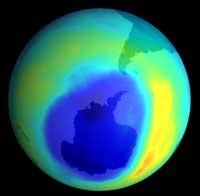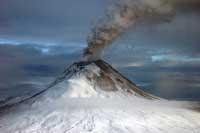Bromine is also consuming ozone

Following the trajectory of the gases emitted by the Kasatochi volcano of Alaska, scientists from the Belgian Institute of Space Aeronomy, which studies the physics and chemistry of the high atmosphere, have discovered that the bromine reaches the stratosphere. For six days the cloud of gases and ashes, more than 11 kilometers long, continued in the violent eruption of the volcano in August 2008.
Scientists have long known that volcanic eruptions have a great influence on the atmosphere and changes in the atmosphere. Until now, however, they did not know that with the volcanoes they came so much joke to the stratosphere. Measurements have revealed that a quarter of the amount of bromine believed to be in the stratosphere has been emitted by volcanic eruptions.
Bromine compounds such as bromine monoxide and bromine nitrate can be very harmful to the ozone layer. The ozone layer and its hole were on everyone's lips a few years ago. In 1985 they discovered the hole, man-made sprays and other products emitted by the famous CFCs.

When they knew that CFCs were harmful their use as aerosols, refrigerants, etc. was prohibited.
CFCs are molecules made up of chlorine, fluorine and carbon that were used in abundance between the 1930s and 1980s as propellers for aerosols and refrigerants, among others, as they saw that in the atmosphere they were very stable molecules.
However, they realized that CFCs in the next atmospheric layer, the stratosphere, would become very reactive by reacting with sunlight. Solar radiation breaks the molecules and one of the components that detach is a chlorine radical, a chlorine atom with great reaction capacity. This chlorine radical has a great tendency to react with ozone molecules and break them. In addition, each radical can destroy thousands of ozone molecules.
Well, brominated compounds are more efficient than chlorine radicals: under the influence of sunlight, chlorine-containing molecules are able to destroy 40 ozone molecules, while those containing bromine destroy 50. What happens is that CFCs are much more abundant than bromine molecules, so they have not given importance to the joke in relation to the ozone hole theme.

The arrival of bromine in the atmosphere is, to some extent, inevitable, as brominated compounds are released into natural phenomena such as volcanoes. (Photo: USGS).
But there seems to be a great risk of bromine becoming more and more important. In fact, to some extent bromine emission is inevitable, as brominated compounds are released into natural phenomena such as volcanoes, while CFC is gradually disappearing from the atmosphere. Its use was prohibited since it was known to be harmful and, in addition, in nature no CFCs occur.
The results obtained, therefore, are not satisfactory, but very useful. In fact, scientists claim that these results will allow them to determine otherwise how many jokes are in the stratosphere. In this way, they will obtain more precise data on the composition of the stratosphere, they will be able to know in more detail the reactions that occur in this part of the atmosphere and better simulate the changes that the stratospheric ozone undergoes.
Published in 7K.
Buletina
Bidali zure helbide elektronikoa eta jaso asteroko buletina zure sarrera-ontzian











